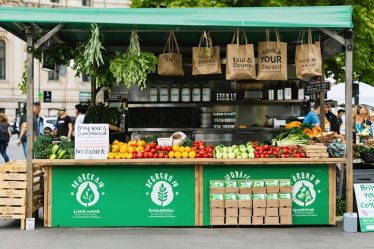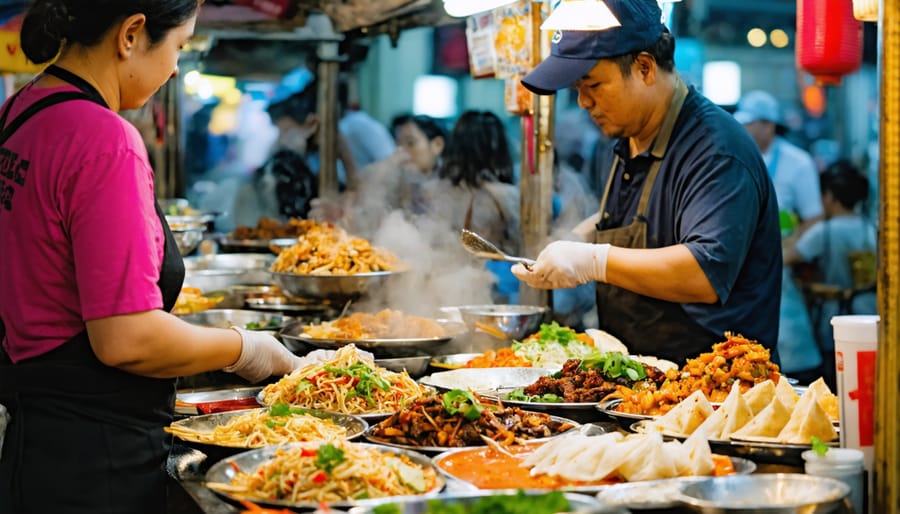
The humble street cart serving steaming plates of pad thai or sizzling tacos represents far more than just a quick meal – it’s a vibrant economic ecosystem that shapes our urban landscape. Every transaction at a street food vendor creates ripples through the local economy, from supporting immigrant entrepreneurs to fostering community connections in ways traditional restaurants rarely achieve. Beyond the irresistible aromas and pocket-friendly prices lies a fascinating world of micro-entrepreneurship, where vendors master the delicate balance of food costs, pricing strategy, and customer relationships to build sustainable businesses from scratch. Their success stories offer powerful lessons in grassroots economics, demonstrating how street food culture simultaneously preserves cultural heritage while driving economic mobility in our cities. Whether you’re a foodie, aspiring entrepreneur, or simply curious about the forces shaping our neighborhoods, understanding street economics reveals how these small-scale vendors collectively generate billions in economic activity while serving up some of the most authentic, affordable, and beloved food experiences in our communities.
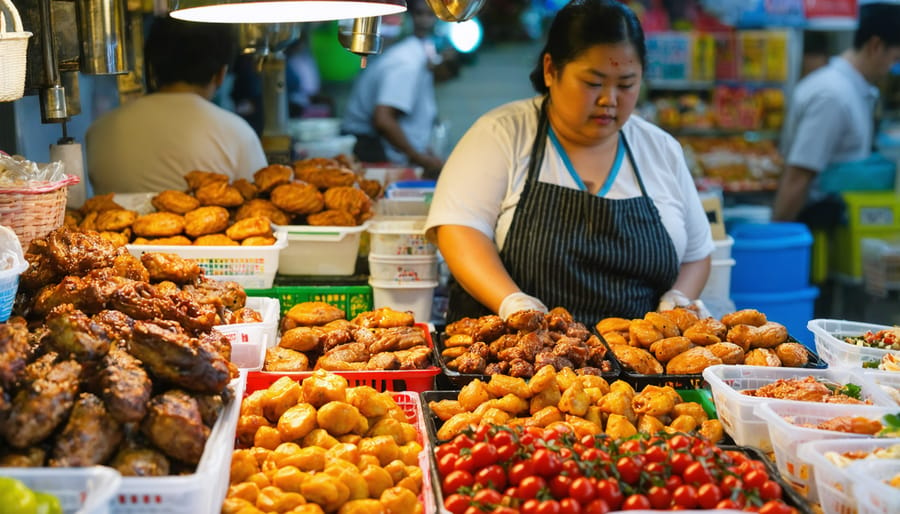
The Hidden Economic Engine of Street Food
Job Creation Beyond the Cart
The impact of street food vendors extends far beyond their carts, creating a fascinating ripple effect throughout the local economy. Just last week, I chatted with Maria, a longtime tamale vendor in my neighborhood, who opened my eyes to this amazing network. She works with three local farms for her ingredients, employs a part-time prep assistant, and even helped her daughter start a social media marketing service for other vendors.
Think of each food cart as the center of a small business ecosystem. Suppliers provide fresh ingredients, packaging materials, and equipment. Local mechanics maintain food trucks and carts, while marketing professionals help vendors build their brands online. Even delivery services have found a new niche partnering with popular street food vendors for lunch rush orders.
The numbers tell an inspiring story: for every successful street food vendor, an estimated 2-3 additional jobs are created in related services. From accountants helping with bookkeeping to local craftspeople building custom cart features, these micro-businesses foster entrepreneurship throughout the community. Some vendors even expand into catering services or restaurant consulting, proving that a humble food cart can be the first step toward building a broader business empire.
Community Wealth Building
When you buy from a street food vendor, you’re doing more than just satisfying your hunger – you’re participating in a beautiful cycle of community wealth building. Unlike large chain restaurants where profits often leave the neighborhood, money spent at street food stalls tends to stay within the local economy, creating what economists call the “multiplier effect.”
Think about Maria, a tamale vendor in my neighborhood. She sources her corn from the local market, buys vegetables from nearby farmers, and gets her packaging supplies from the corner store. These sustainable local food practices create a network of economic relationships that strengthen our community.
When customers buy Maria’s tamales, that money doesn’t just support her family – it ripples through the neighborhood. She pays local suppliers, who in turn spend at other local businesses. Her employees, often from the same community, spend their wages at nearby shops. Even the tips her customers leave might help send her children to local tutoring services or after-school programs.
This economic ecosystem creates a resilient local economy, where wealth circulates and grows within the community rather than being extracted by large corporations. It’s a prime example of how small-scale food businesses can become powerful engines of neighborhood prosperity.
The Real Cost of Running a Food Cart
Start-up Costs vs. Restaurant Opening
When I chatted with Maria, a successful restaurant owner who started with a food truck, she shared an eye-opening perspective: “Starting my street food business cost me around $15,000, while my brick-and-mortar restaurant required nearly $200,000.” This dramatic difference in startup costs is why many aspiring food entrepreneurs are turning to street food as their entry point into the culinary world.
Let’s break down the numbers: A basic food cart setup might require $5,000-$20,000, including equipment, permits, and initial inventory. Compare this to a traditional restaurant, where you’re looking at $100,000-$500,000 for everything from kitchen equipment to interior design, not to mention rent deposits and licensing fees.
The beauty of street food operations lies in their flexibility and lower overhead costs. You won’t need to worry about expensive restaurant furniture, extensive kitchen renovations, or long-term lease commitments. Plus, many street food vendors test their concept and build a loyal following before making the leap to a permanent location.
However, it’s important to note that lower startup costs don’t automatically mean easier success. Street food vendors face their own unique challenges, from weather dependencies to limited storage space. But for many, these trade-offs are worth it for the chance to pursue their culinary dreams without taking on massive debt.
Daily Operations and Profit Margins
Ever wondered how street food vendors manage their daily finances? Let me break it down for you, based on conversations I’ve had with local vendors in my community. Running successful budget-friendly food operations requires careful planning and smart money management.
A typical food cart vendor’s day starts with purchasing fresh ingredients, usually costing between $100-150. Daily operational costs include propane ($15-20), packaging materials ($25-30), and transportation ($20-25). Don’t forget about permits and licenses, which average about $10-15 when broken down per day.
The good news? Many vendors report daily sales ranging from $300-500, depending on location and weather conditions. After deducting all expenses, including a portion for equipment maintenance and unexpected costs, the average daily profit typically falls between $80-150.
Here’s a tip I learned from Maria, a successful taco vendor in my neighborhood: tracking every penny helps optimize profits. She suggests keeping separate containers for different expense categories and always setting aside 10% of daily earnings for emergencies or future investments.
Weather plays a huge role in daily earnings – sunny days can double profits, while rainy days might barely break even. That’s why many successful vendors diversify their income streams by catering private events or offering delivery services during off-peak hours.
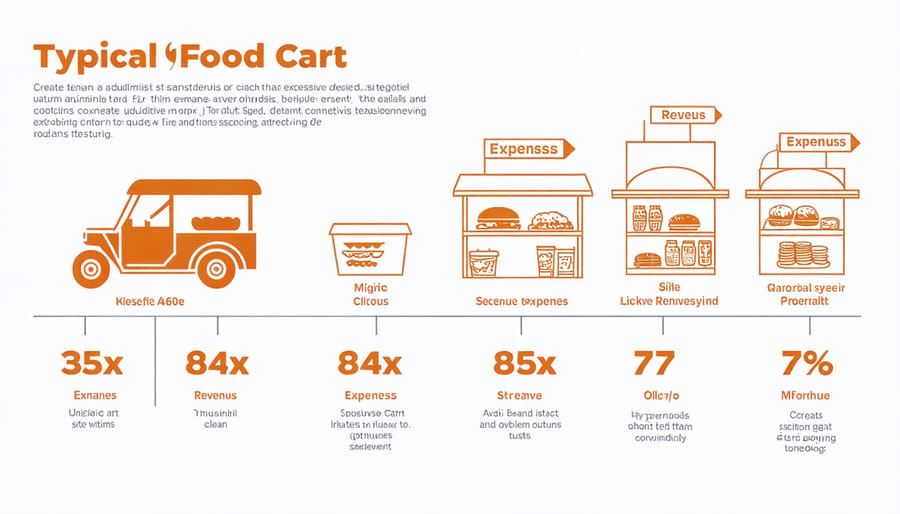
From Street Cart to Success Story
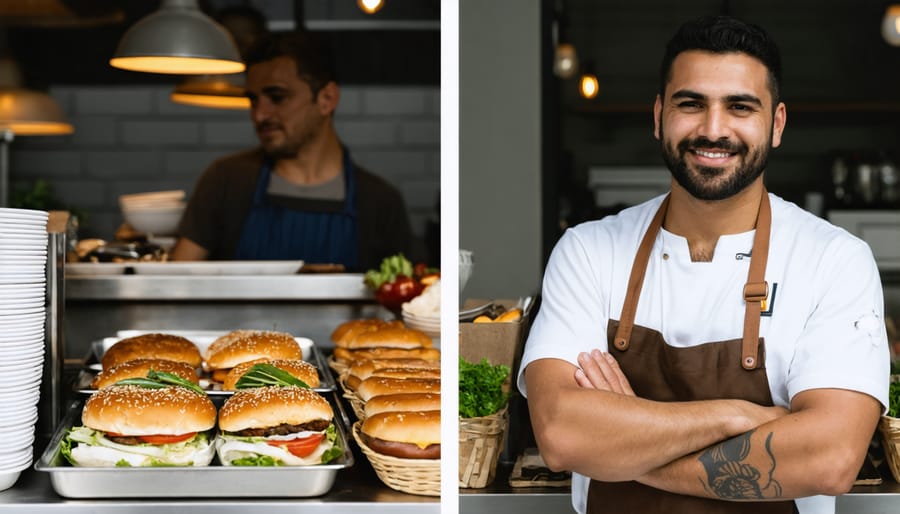
Local Success Stories
Meet Maria, who transformed her grandmother’s tamale recipe into a thriving street food empire. Starting with just a small cart and $500 in savings, she now operates three food trucks and employs seven people from her community. “The secret,” she says, “isn’t just in the recipe—it’s understanding your customers and being consistent.”
Then there’s James, a former corporate chef who found his calling serving fusion tacos from a street corner. Within two years, his creative combinations and strategic location choices near office buildings led to a loyal customer base and social media following of over 50,000 fans.
Sarah and Tom, a husband-wife duo, started selling homemade ice cream sandwiches at local festivals. Their commitment to using local ingredients and creating seasonal flavors caught the attention of food bloggers. Today, they’ve expanded to three permanent kiosks and regularly cater corporate events.
Perhaps most inspiring is Mei’s story. A recent immigrant, she started selling authentic dumplings from a small cart. Through word-of-mouth and participation in food festivals, she secured funding from a local business development program. Now, she mentors other vendors and runs a successful catering business alongside her street operations.
Growth Strategies That Work
The path to building a successful food business often starts small but grows through strategic thinking. I’ve watched countless street food vendors evolve from single carts to thriving enterprises, and their success typically follows similar patterns.
First, they perfect a signature dish that becomes their calling card. Whether it’s perfectly seasoned tacos or innovative fusion cuisine, this foundation creates loyal customers who spread the word. Smart vendors then leverage social media to build buzz and announce their locations, turning occasional buyers into dedicated followers.
The next step usually involves expanding operating hours and testing different locations to maximize foot traffic. Many successful vendors partner with local events and festivals, which not only increases exposure but also creates valuable community connections.
Once they’ve established a strong customer base, the most successful vendors often explore multiple revenue streams. This might mean adding catering services, creating packaged versions of their popular sauces, or opening a second cart in a high-traffic area. The key is growing gradually while maintaining the quality and personal touch that made them successful in the first place.
Supporting Your Local Food Economy
There’s something magical about the aroma of street food wafting through your neighborhood, isn’t it? As someone who’s fallen in love with my local food scene, I’ve discovered that supporting local food vendors isn’t just about satisfying our cravings – it’s about building a stronger, more vibrant community.
Let me share some practical ways you can become an active participant in your local food economy while enjoying delicious benefits along the way. First, make it a habit to carry cash when you’re out and about. While many vendors now accept cards, cash transactions often help them avoid processing fees, keeping more money in their pockets.
Consider becoming a regular at your favorite spots. When vendors can count on steady customers, they’re better able to plan their inventory and reduce waste. Plus, you’ll likely be rewarded with extra portions or insider tips about daily specials! I’ve found that my regular vendor always lets me know when she’s planning to make her famous spring rolls – a perk of being a familiar face.
Social media can be a powerful tool for supporting your local food scene. Share your favorite finds on Instagram, leave positive reviews, and follow your go-to vendors to stay updated on their locations and specials. Your posts might inspire others in your network to explore these hidden gems.
Another meaningful way to support street food vendors is to engage with them during off-peak hours. That morning coffee or afternoon snack purchase can help smooth out their daily revenue, making their business more sustainable. I’ve had some of my most interesting conversations with vendors during these quieter moments.
Consider organizing food tours or meetups with friends to explore different vendors in your area. This not only creates a fun social experience but also introduces new customers to these businesses. You might be surprised how many of your friends haven’t discovered that amazing taco stand or legendary dumpling cart yet!
Lastly, don’t forget to ask vendors about their stories and specialties. Many street food entrepreneurs have fascinating backgrounds and take immense pride in their craft. Understanding their journey not only enriches your experience but helps create meaningful connections within your community.
Remember, every purchase you make is a vote for the kind of community you want to live in. By choosing to support street food vendors, you’re helping preserve local flavors, create jobs, and maintain the unique character of your neighborhood.
When I think about the vibrant street food scene in my neighborhood, I’m reminded that it’s so much more than just delicious meals on wheels. Street food vendors are the heartbeat of our local economy, creating a ripple effect that touches every corner of our community.
These enterprising individuals aren’t just feeding hungry customers; they’re building sustainable micro-economies that support local farmers, create jobs, and keep money circulating within our neighborhoods. I’ve watched as Maria, our local tamale vendor, gradually expanded from a one-woman operation to employing three local residents, all while sourcing her ingredients from the nearby farmers’ market.
Street food also plays a crucial role in preserving cultural heritage while fostering innovation. It provides an accessible entry point for aspiring entrepreneurs, particularly immigrants and women, to establish themselves in the business world without the overwhelming costs of traditional restaurants.
The future of our cities’ economic health may well depend on these small-scale food entrepreneurs. They create walkable, social spaces that attract foot traffic to other local businesses, enhance neighborhood safety through their presence, and build the kind of community connections that make our cities more resilient.
By supporting street food vendors, we’re not just satisfying our cravings – we’re investing in the economic and social fabric of our communities. It’s a delicious way to contribute to a more sustainable, inclusive, and vibrant local economy.

